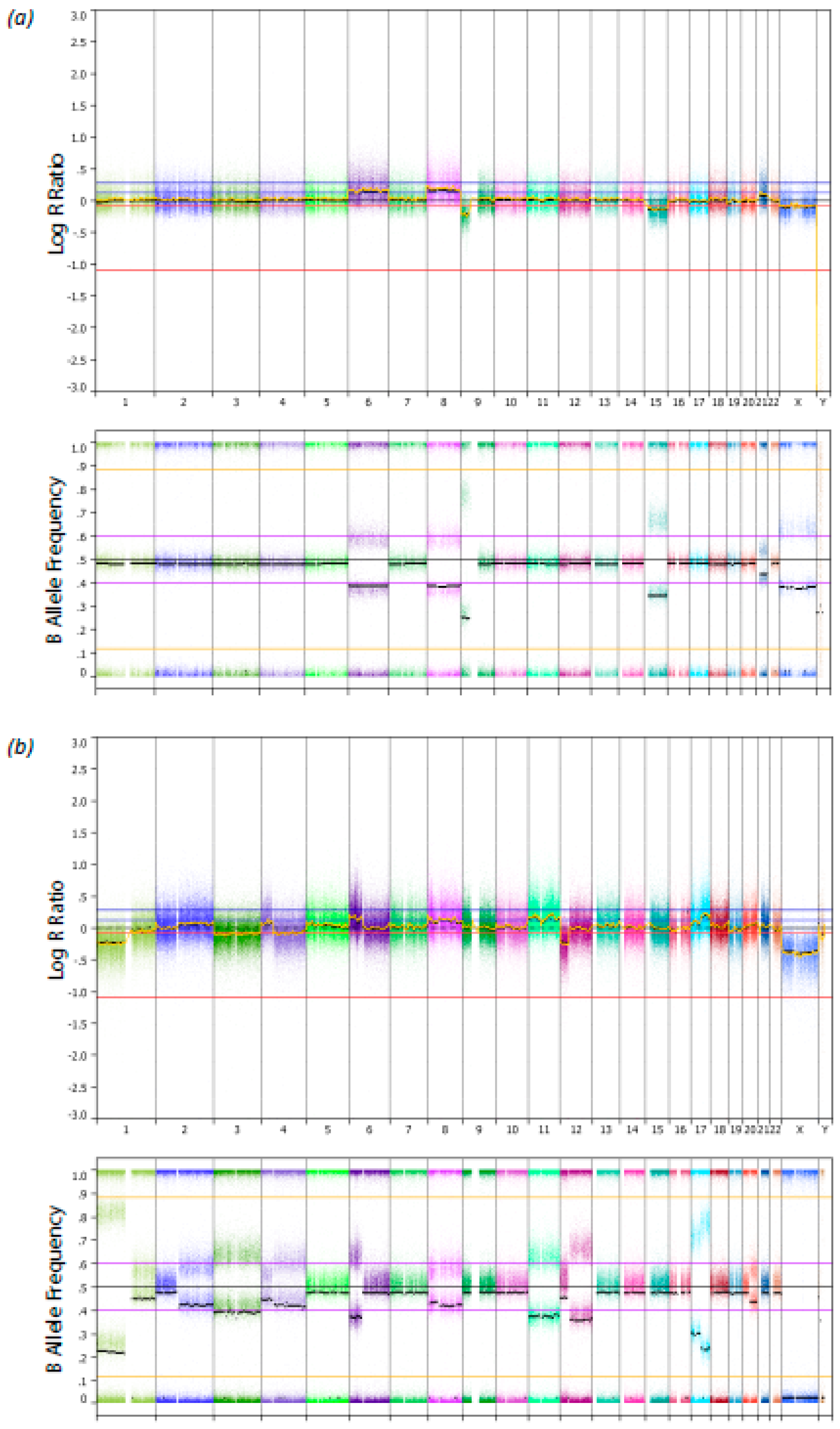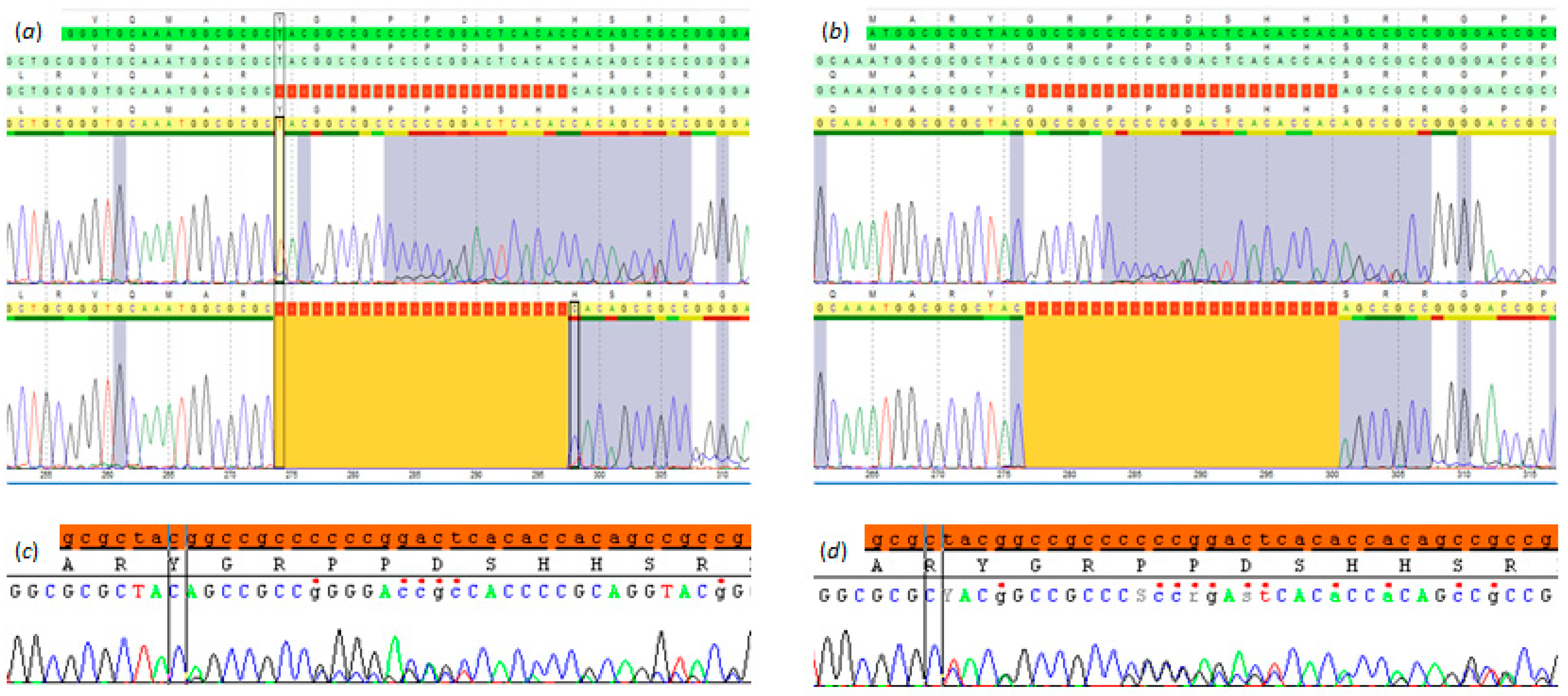SRSF2 Mutations in Uveal Melanoma: A Preference for In-Frame Deletions?
Abstract
1. Introduction
2. Results
3. Discussion
4. Materials and Methods
5. Conclusions
Author Contributions
Funding
Acknowledgments
Conflicts of Interest
References
- Delgado-Ramos, G.M.; Thomas, F.; VanderWalde, A.; King, B.; Wilson, M.; Pallera, A.M. Risk factors, clinical outcomes, and natural history of uveal melanoma: A single-institution analysis. Med. Oncol. 2019, 36, 17. [Google Scholar] [CrossRef] [PubMed]
- Vichitvejpaisal, P.; Dalvin, L.A.; Mazloumi, M.; Ewens, K.G.; Ganguly, A.; Shields, C.L. Genetic Analysis of Uveal Melanoma in 658 Patients using The Cancer Genome Atlas (TCGA) Classification of Uveal Melanoma as A, B, C & D. Ophthalmology 2019, in press. [Google Scholar]
- Yavuzyigitoglu, S.; Koopmans, A.E.; Verdijk, R.M.; Vaarwater, J.; Eussen, B.; Van Bodegom, A.; Paridaens, D.; Kiliç, E.; de Klein, A. Rotterdam Ocular Melanoma Study Group. Uveal Melanomas with SF3B1 Mutations: A Distinct Subclass Associated with Late-Onset Metastases. Ophthalmology 2016, 123, 1118–1128. [Google Scholar] [CrossRef] [PubMed]
- Ewens, K.G.; Kanetsky, P.A.; Richards-Yutz, J.; Purrazzella, J.; Shields, C.L.; Ganguly, T.; Ganguly, A. Chromosome 3 status combined with BAP1 and EIF1AX mutation profiles are associated with metastasis in uveal melanoma. Investig. Ophthalmol. Vis. Sci. 2014, 55, 5160–5167. [Google Scholar] [CrossRef] [PubMed]
- Yavuzyigitoglu, S.; Drabarek, W.; Smit, K.N.; van Poppelen, N.; Koopmans, A.E.; Vaarwater, J.; Brands, T.; Eussen, B.; Dubbink, H.J.; van Riet, J.; et al. Correlation of Gene Mutation Status with Copy Number Profile in Uveal Melanoma. Ophthalmology 2017, 124, 573–575. [Google Scholar] [CrossRef] [PubMed]
- Yoshida, K.; Sanada, M.; Shiraishi, Y.; Nowak, D.; Nagata, Y.; Yamamoto, R.; Sato, Y.; Sato-Otsubo, A.; Kon, A.; Nagasaki, M.; et al. Frequent pathway mutations of splicing machinery in myelodysplasia. Nature 2011, 478, 64–69. [Google Scholar] [CrossRef] [PubMed]
- Tefferi, A.; Mudireddy, M.; Finke, C.M.; Nicolosi, M.; Lasho, T.L.; Hanson, C.A.; Patnaik, M.M.; Pardanani, A.; Gangat, N. U2AF1 mutation variants in myelodysplastic syndromes and their clinical correlates. Am. J. Hematol. 2018, 93, E146–E148. [Google Scholar] [CrossRef] [PubMed]
- Wu, S.J.; Kuo, Y.Y.; Hou, H.A.; Li, L.Y.; Tseng, M.H.; Huang, C.F.; Lee, F.Y.; Liu, M.C.; Liu, C.W.; Lin, C.T.; et al. The clinical implication of SRSF2 mutation in patients with myelodysplastic syndrome and its stability during disease evolution. Blood 2012, 120, 3106–3111. [Google Scholar] [CrossRef] [PubMed]
- Je, E.M.; Yoo, N.J.; Kim, Y.J.; Kim, M.S.; Lee, S.H. Mutational analysis of splicing machinery genes SF3B1, U2AF1 and SRSF2 in myelodysplasia and other common tumors. Int. J. Cancer 2013, 133, 260–265. [Google Scholar] [CrossRef] [PubMed]
- Meggendorfer, M.; Roller, A.; Haferlach, T.; Eder, C.; Dicker, F.; Grossmann, V.; Kohlmann, A.; Alpermann, T.; Yoshida, K.; Ogawa, S.; et al. SRSF2 mutations in 275 cases with chronic myelomonocytic leukemia (CMML). Blood 2012, 120, 3080–3088. [Google Scholar] [CrossRef] [PubMed]
- Field, M.G.; Durante, M.A.; Anbunathan, H.; Cai, L.Z.; Decatur, C.L.; Bowcock, A.M.; Kurtenbach, S.; Harbour, J.W. Punctuated evolution of canonical genomic aberrations in uveal melanoma. Nat. Commun. 2018, 9, 116. [Google Scholar] [CrossRef] [PubMed]
- Graubert, T.A.; Shen, D.; Ding, L.; Okeyo-Owuor, T.; Lunn, C.L.; Shao, J.; Krysiak, K.; Harris, C.C.; Koboldt, D.C.; Larson, D.E.; et al. Recurrent mutations in the U2AF1 splicing factor in myelodysplastic syndromes. Nat. Genet. 2011, 44, 53–57. [Google Scholar] [CrossRef] [PubMed]
- Smit, K.N.; Van Poppelen, N.M.; Vaarwater, J.; Verdijk, R.; van Marion, R.; Kalirai, H.; Coupland, S.E.; Thornton, S.; Farquhar, N.; Dubbink, H.J.; et al. Combined mutation and copy-number variation detection by targeted next-generation sequencing in uveal melanoma. Mod. Pathol. 2018, 31, 763–771. [Google Scholar] [CrossRef] [PubMed]
- Koopmans, A.E.; Verdijk, R.M.; Brouwer, R.W.; Van Den Bosch, T.P.; Van Den Berg, M.M.; Vaarwater, J.; Kockx, C.E.; Paridaens, D.; Naus, N.C.; Nellist, M.; et al. Clinical significance of immunohistochemistry for detection of BAP1 mutations in uveal melanoma. Mod. Pathol. 2014, 27, 1321–1330. [Google Scholar] [CrossRef] [PubMed]
- Yang, J.; Yao, D.M.; Ma, J.C.; Yang, L.; Guo, H.; Wen, X.M.; Xiao, G.F.; Qian, Z.; Lin, J.; Qian, J. The prognostic implication of SRSF2 mutations in Chinese patients with acute myeloid leukemia. Tumour Biol. 2016, 37, 10107–10114. [Google Scholar] [CrossRef] [PubMed]
- Afshar, A.R.; Damato, B.E.; Stewart, J.M.; Zablotska, L.B.; Roy, R.; Olshen, A.B.; Joseph, N.M.; Bastian, B.C. Next-Generation Sequencing of Uveal Melanoma for Detection of Genetic Alterations Predicting Metastasis. Transl. Vis. Sci. Technol. 2019, 8, 18. [Google Scholar] [CrossRef] [PubMed]
- Robertson, A.G.; Shih, J.; Yau, C.; Gibb, E.A.; Oba, J.; Mungall, K.L.; Hess, J.M.; Uzunangelov, V.; Walter, V.; Danilova, L.; et al. Integrative Analysis Identifies Four Molecular and Clinical Subsets in Uveal Melanoma. Cancer Cell 2017, 32, 204–220. [Google Scholar] [CrossRef] [PubMed]


| UM 1 | UM 2 | |
|---|---|---|
| Clinical characteristics | ||
| Sex | Female | Male |
| Age at diagnosis (years) | 63.0 | 57.3 |
| Metastasis | No | No |
| Disease free survival (months) | 76.8 | 128.8 |
| Mutation status | ||
| SRSF2 | Chr17(GRCh37):g.74732946_74732969del c.274_297del:p.(Tyr92_His99del) | Chr17(GRCh37):g.74732943_74732966del c.277_300del:p.(Gly93_His100del) |
| U2AF1 | Wildtype | Wildtype |
| GNAQ | Chr9(GRCh37):g.80409488T > A c.626A > T:p.(Gln209Leu) | Chr9(GRCh37):g.80409488T > A c.626A > T:p.(Gln209Leu) |
| GNA11 | Wildtype | Wildtype |
| SF3B1 | Wildtype | Wildtype |
| BAP1 | Wildtype | Wildtype |
| EIF1AX | Wildtype | Wildtype |
| Copy number variation | ||
| (Partial) gain of chromosome | 6, 8, 21 | 2q, 6p, 8, 11, 17, 20q |
| (Partial) loss of chromosome | 9p, 15 | 1p, 3, 4q, 12p |
| SRSF2 | U2AF1 | GNAQ | GNA11 | BAP1 | EIF1AX | |
|---|---|---|---|---|---|---|
| 1. ROMS | c.274_297del:p.(Tyr92_His99del) | Wildtype | c.626A > T:p.(Gln209Leu) | Wildtype | Wildtype | Wildtype |
| 2. ROMS | c.277_300del:p.(Gly93_His100del) | Wildtype | c.626A > T:p.(Gln209Leu) | Wildtype | Wildtype | Wildtype |
| 3. TCGA | c.274_297del:p.(Tyr92_His99del) | Wildtype | c.626A > T:p.(Gln209Leu) | Wildtype | Wildtype | Wildtype |
| 4. TCGA | c.274_300del:p.(Tyr92_His100del) | Wildtype | Wildtype | c.626A > T:p.(Gln209Leu) | Wildtype | Wildtype |
| 5. TCGA | c.519_536del:p.(Ser174_Ser179del) | Wildtype | Wildtype | c.626A > T:p.(Gln209Leu) | c.518A > G:p.(Tyr173Cys) | Wildtype |
© 2019 by the authors. Licensee MDPI, Basel, Switzerland. This article is an open access article distributed under the terms and conditions of the Creative Commons Attribution (CC BY) license (http://creativecommons.org/licenses/by/4.0/).
Share and Cite
van Poppelen, N.M.; Drabarek, W.; Smit, K.N.; Vaarwater, J.; Brands, T.; Paridaens, D.; Kiliç, E.; de Klein, A. SRSF2 Mutations in Uveal Melanoma: A Preference for In-Frame Deletions? Cancers 2019, 11, 1200. https://doi.org/10.3390/cancers11081200
van Poppelen NM, Drabarek W, Smit KN, Vaarwater J, Brands T, Paridaens D, Kiliç E, de Klein A. SRSF2 Mutations in Uveal Melanoma: A Preference for In-Frame Deletions? Cancers. 2019; 11(8):1200. https://doi.org/10.3390/cancers11081200
Chicago/Turabian Stylevan Poppelen, Natasha M., Wojtek Drabarek, Kyra N. Smit, Jolanda Vaarwater, Tom Brands, Dion Paridaens, Emine Kiliç, and Annelies de Klein. 2019. "SRSF2 Mutations in Uveal Melanoma: A Preference for In-Frame Deletions?" Cancers 11, no. 8: 1200. https://doi.org/10.3390/cancers11081200
APA Stylevan Poppelen, N. M., Drabarek, W., Smit, K. N., Vaarwater, J., Brands, T., Paridaens, D., Kiliç, E., & de Klein, A. (2019). SRSF2 Mutations in Uveal Melanoma: A Preference for In-Frame Deletions? Cancers, 11(8), 1200. https://doi.org/10.3390/cancers11081200





